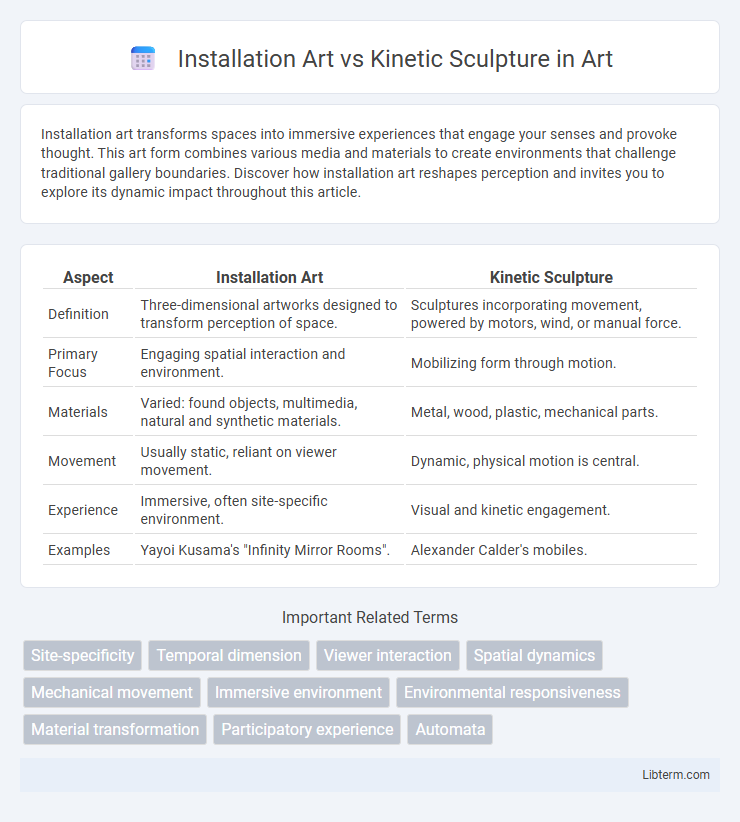Installation art transforms spaces into immersive experiences that engage your senses and provoke thought. This art form combines various media and materials to create environments that challenge traditional gallery boundaries. Discover how installation art reshapes perception and invites you to explore its dynamic impact throughout this article.
Table of Comparison
| Aspect | Installation Art | Kinetic Sculpture |
|---|---|---|
| Definition | Three-dimensional artworks designed to transform perception of space. | Sculptures incorporating movement, powered by motors, wind, or manual force. |
| Primary Focus | Engaging spatial interaction and environment. | Mobilizing form through motion. |
| Materials | Varied: found objects, multimedia, natural and synthetic materials. | Metal, wood, plastic, mechanical parts. |
| Movement | Usually static, reliant on viewer movement. | Dynamic, physical motion is central. |
| Experience | Immersive, often site-specific environment. | Visual and kinetic engagement. |
| Examples | Yayoi Kusama's "Infinity Mirror Rooms". | Alexander Calder's mobiles. |
Understanding Installation Art: Definition and Key Features
Installation art immerses viewers by transforming spaces into interactive, multi-sensory experiences that challenge traditional art boundaries. Key features include site-specificity, the integration of various materials, and an emphasis on the viewer's spatial relationship with the artwork. Unlike kinetic sculpture, installation art prioritizes environment engagement over mechanical movement.
What Defines Kinetic Sculpture? Essential Characteristics
Kinetic sculpture is defined by its incorporation of movement as a fundamental element, often powered by wind, motors, or viewer interaction, distinguishing it from static installation art. Essential characteristics include dynamic motion, the integration of mechanical components, and the ability to change appearance or form over time, creating an evolving visual experience. This form merges engineering with artistic expression, emphasizing physical transformation as a core aspect of the work.
Historical Origins: Evolution of Installation Art and Kinetic Sculpture
Installation art originated in the 1960s as artists sought immersive environments, diverging from traditional sculpture by integrating space, light, and objects to create experiential works. Kinetic sculpture emerged earlier in the early 20th century, influenced by Futurism and Constructivism, emphasizing movement powered by wind, motors, or the observer. Both forms evolved from modernist experimentation, with installation art expanding spatial engagement and kinetic sculpture highlighting dynamic physical motion.
Materials and Mediums: Comparing Creative Approaches
Installation art incorporates diverse materials such as found objects, light, sound, and video to create immersive, site-specific experiences that transform space. Kinetic sculpture primarily uses mechanical parts, motors, and metals like steel or aluminum to produce movement and engage viewers through physical dynamics. Materials in installation art often emphasize sensory interaction and environment alteration, whereas kinetic sculpture focuses on engineering and motion as central creative elements.
Space and Interaction: Audience Engagement in Both Forms
Installation art transforms physical space by immersing viewers in a carefully designed environment, encouraging sensory and emotional interaction beyond mere observation. Kinetic sculpture emphasizes movement within its form, inviting audiences to experience the dynamic interplay of motion and space, often responding to environmental factors like wind or touch. Both art forms redefine traditional viewer roles by fostering active engagement, but installation art prioritizes spatial immersion while kinetic sculpture centers on mechanical or natural motion to elicit interaction.
Motion and Stillness: The Role of Movement in Artistic Expression
Installation art often emphasizes stillness within a carefully constructed environment, inviting viewers to explore spatial relationships and sensory experiences at their own pace. Kinetic sculpture incorporates actual movement through mechanical or natural forces, creating dynamic interactions that challenge traditional notions of static art forms. The role of motion in kinetic sculpture highlights the temporal dimension of art, whereas installation art uses stillness to evoke contemplation and immersive presence.
Influential Artists: Pioneers of Installation Art and Kinetic Sculpture
Pioneers of Installation Art include artists like Joseph Beuys, known for integrating social and political themes into immersive environments, and Yayoi Kusama, whose infinity rooms transform space through repetitive patterns and light. Kinetic Sculpture was significantly advanced by Alexander Calder, whose mobiles introduced dynamic motion as a core artistic element, and Jean Tinguely, whose mechanical sculptures emphasize movement and unpredictability. These influential artists each expanded their mediums, challenging traditional boundaries and inspiring new forms of interactive, experiential art.
Display and Preservation: Challenges Unique to Each Art Form
Installation art demands extensive spatial considerations for display, often requiring site-specific environments that influence audience interaction and complicate preservation due to its often ephemeral materials. Kinetic sculpture focuses on movement mechanisms, necessitating continuous maintenance and climate-controlled settings to prevent mechanical degradation and material fatigue. Both art forms face unique conservation challenges: installation art struggles with preserving temporary or altered spaces, while kinetic sculptures require specialized technical expertise to maintain functionality over time.
Conceptual Intent: Exploring Underlying Themes and Messages
Installation art often emphasizes immersive environments designed to provoke reflection on social, political, or cultural issues through spatial experience and viewer interaction. Kinetic sculpture highlights movement and mechanical aspects to explore themes of time, change, and physical forces, engaging viewers through dynamic visual effects. Both forms use their unique sensory approaches to convey conceptual intent, with installation art prioritizing narrative space and kinetic sculpture focusing on motion-based symbolism.
Future Trends: The Convergence of Installation Art and Kinetic Sculpture
Future trends in contemporary art reveal a growing convergence between installation art and kinetic sculpture, driven by advancements in interactive technology and robotics. Artists increasingly integrate motion sensors, programmable motors, and augmented reality to create immersive, dynamic environments that blur the boundaries between static and moving forms. This fusion expands experiential possibilities, enabling audiences to engage with artworks in multisensory ways that redefine spatial perception and interactivity.
Installation Art Infographic

 libterm.com
libterm.com